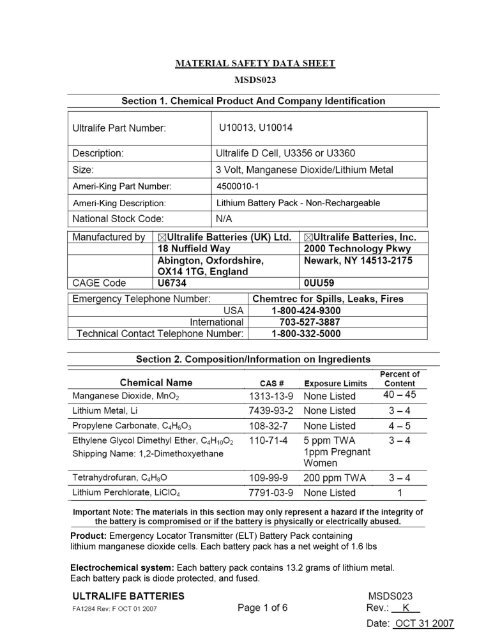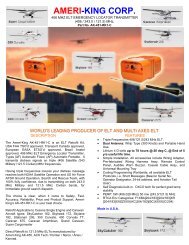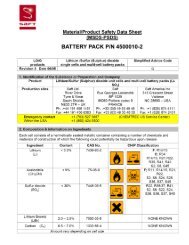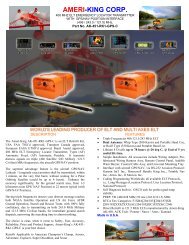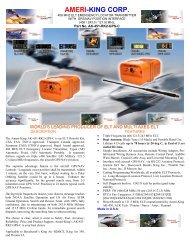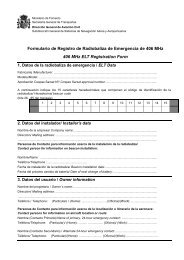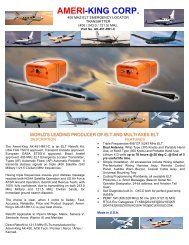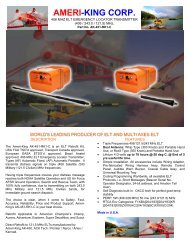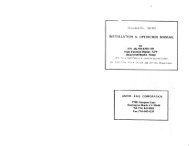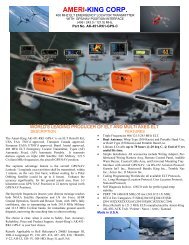MSDS for Battery Pack 4500010-1 LiMnO2 ... - Ameri-King.com
MSDS for Battery Pack 4500010-1 LiMnO2 ... - Ameri-King.com
MSDS for Battery Pack 4500010-1 LiMnO2 ... - Ameri-King.com
Create successful ePaper yourself
Turn your PDF publications into a flip-book with our unique Google optimized e-Paper software.
Section 3. Hazards Identification<br />
3.1 Emergency overview: May leak and /or flame if opened, recharged,<br />
connected improperly, or disposed of in fire.<br />
3.2 Potential health effects: Skin contact may cause irritation and absorption.<br />
Contact with raw lithium may cause burns.<br />
Routes of entry: Inhalation or ingestion of electrolyte may have toxic effects.<br />
Acute exposure: Electrolyte may irritate skin and eyes.<br />
Effects of chronic exposure: Electrolyte contains a teratogen<br />
3.3 Perchlorate Material - special handling may apply. See<br />
www.dtsc.ca.gov/hazardouswaste.<br />
Section 4. First Aid Measures<br />
Electrolyte Contact<br />
Skin- Immediately flush with plenty of water <strong>for</strong> at least 15 minutes. If symptoms<br />
are present after flushing, get medical attention.<br />
Eyes- Immediately flush with plenty of water <strong>for</strong> at least 15 minutes and get<br />
medical attention.<br />
Lithium Metal Contact<br />
Skin- Remove particles of lithium from skin as rapidly as possible. Immediately<br />
flush with plenty of water <strong>for</strong> at least 15 minutes and get medical attention.<br />
Eyes- Immediately flush with plenty of water <strong>for</strong> at least 15 minutes and get<br />
immediate medical attention.<br />
Section 5. Fire Fighting Measures<br />
Extinguishing Media:<br />
Copious amounts of cold water are an effective extinguishing medium <strong>for</strong> lithium<br />
batteries. Do not use warm or hot water.<br />
Do not use Halon type extinguishing material.<br />
Fire Fighting Procedures<br />
Use a positive pressure self-contained breathing apparatus if batteries are<br />
involved in a fire.<br />
Full protective clothing is necessary.<br />
During water application, caution is advised as burning pieces of lithium may be<br />
ejected from the fire.<br />
Unusual Fire and Explosion Hazards<br />
Batteries may flame or leak potentially hazardous organic vapors if exposed to<br />
excessive heat or fire.<br />
Hazardous <strong>com</strong>bustion products<br />
Fire or excessive heat may produce hazardous de<strong>com</strong>position products.<br />
Damaged or opened batteries can result in rapid heating and the release of<br />
flammable vapors. Vapors are heavier than air and may travel along the<br />
ground or be moved by ventilation to an ignition source and flash back.<br />
ULTRALIFE BATTERIES<br />
<strong>MSDS</strong>023<br />
FA1284 Rev: F OCT 01 2007 Page 2 of 6 Rev.: K<br />
Date: OCT 31 2007
Section 6. Accidental Release Measures<br />
Damaged batteries that are not hot or burning should be placed in a sealed plastic<br />
bag or container.<br />
Section 7. Handling And Storage<br />
Do not store batteries in a manner that allows terminals to short circuit.<br />
Batteries should be separated from other materials and stored in a non-<strong>com</strong>bustible,<br />
well ventilated, sprinkler-protected structure with sufficient clearance between walls<br />
and battery stacks. Do not place batteries near heating equipment, nor expose to<br />
direct sunlight <strong>for</strong> long periods<br />
Batteries should be stored in a dry area at temperatures no higher than 85°C<br />
(194°F). Air conditioning or cooling is not required unless excessively high<br />
temperatures above 90°C (194°F) will be encountered. Elevated storage<br />
temperatures above 72°C (162°F) can result in reduced battery shelf life and service<br />
life, and should be avoided. Batteries should be kept as cool as possible in order to<br />
maximize shelf life and service life.<br />
Batteries are not designed to be recharged. Charging a battery may result in<br />
electrolyte leakage and/ or cause the battery to flame.<br />
Never disassemble a battery.<br />
Should a battery unintentionally be crushed, thus releasing its contents, rubber<br />
gloves must be used to handle all battery <strong>com</strong>ponents. Avoid inhalation of any<br />
vapors that may be emitted.<br />
In the event of skin or eye exposure to the electrolyte, refer to<br />
Section 4, First Aid Measures.<br />
More than a momentary short circuit will generally reduce the battery service life.<br />
Batteries with fuses will no longer be functional after being shorted.<br />
Extended short circuiting creates high temperatures in the cell. High temperatures<br />
can cause burns in skin or cause the cell to flame.<br />
Avoid reversing battery polarity within the battery assembly. To do so may cause<br />
cell to flame or to leak.<br />
The use of old and new batteries or batteries of varying sizes and types in the same<br />
battery assembly should be avoided. The batteries’ electrical characteristics and<br />
capabilities vary and damage may result to batteries or electrical equipment.<br />
ULTRALIFE BATTERIES<br />
<strong>MSDS</strong>023<br />
FA1284 Rev: F OCT 01 2007 Page 3 of 6 Rev.: K<br />
Date: OCT 31 2007
Section 8. Exposure Controls/Personal Protection<br />
No engineering controls are required <strong>for</strong> handling batteries that have not been<br />
damaged. Personal protective equipment <strong>for</strong> damaged batteries should include<br />
chemical resistant gloves and safety glasses. In the event of a fire, SCBA should be<br />
worn along with thermally protective outer garments.<br />
Not Applicable<br />
Section 9. Physical And Chemical Properties<br />
Section 10. Stability And Reactivity<br />
(1) This product is stable under ordinary conditions of use and storage.<br />
(2) It is not re<strong>com</strong>mended that this product be stored above 85°C (194°F).<br />
(3) Damaged batteries will react with water. Non-discharged batteries contain<br />
elemental Lithium. This is water reactive. This reaction gives off heat and hydrogen<br />
gas. A thermal reaction may occur.<br />
(4) Hazardous de<strong>com</strong>position products: Carbon Monoxide (CO), and<br />
Hydrogen Flouride (HF)<br />
Section 11. Toxicological In<strong>for</strong>mation<br />
(1) Irritancy: The electrolytes contained in this battery can irritate eyes with any<br />
contact. Prolonged contact with the skin or mucous membranes may cause<br />
irritation.<br />
(2) Sensitization: No in<strong>for</strong>mation is available at this time.<br />
(3) Carcinogenicity: No in<strong>for</strong>mation is available at this time.<br />
(4) Reproductive toxicity: No in<strong>for</strong>mation is available at this time.<br />
(5) Teratogenicity: This product contains a known teratogen as indicated in the<br />
chemical in<strong>for</strong>mation in section 2.<br />
(6) Mutagenicity: No in<strong>for</strong>mation is available at this time.<br />
Not applicable to this material/product.<br />
Section 12. Ecological In<strong>for</strong>mation<br />
Section 13. Disposal Considerations<br />
Batteries must be <strong>com</strong>pletely discharged prior to disposal and/ or the terminals must<br />
be taped or capped to prevent short circuit. This product does not contain any<br />
materials listed by the United Stated EPA as requiring specific waste disposal<br />
requirements. When <strong>com</strong>pletely discharged it is not considered hazardous. Disposal<br />
of large quantities of lithium power cells may be subject to Federal, State, or Local<br />
regulations. Consult your local, state and provincial regulations regarding disposal<br />
of these batteries.<br />
ULTRALIFE BATTERIES<br />
<strong>MSDS</strong>023<br />
FA1284 Rev: F OCT 01 2007 Page 4 of 6 Rev.: K<br />
Date: OCT 31 2007
Section 15. Regulatory In<strong>for</strong>mation<br />
USA: This <strong>MSDS</strong> meets/exceeds OSHA requirements.<br />
Canada: This product has been classified in accordance with the hazard criteria of<br />
the Controlled Products Regulations and the <strong>MSDS</strong> contains all of the in<strong>for</strong>mation<br />
required by those regulations.<br />
International: This <strong>MSDS</strong> con<strong>for</strong>ms to European Union (EU), the International<br />
Standards Organization (ISO) and the International Labour Organization (ILO) and<br />
as documented in ANSI (<strong>Ameri</strong>can National Standards Institute) Standard Z400.1-<br />
1993.<br />
Section 16. Other In<strong>for</strong>mation<br />
The in<strong>for</strong>mation contained herein is furnished without warranty of any kind. Users<br />
should consider this data only as a supplement to other in<strong>for</strong>mation gathered by<br />
them and must make independent determinations of the suitability and<br />
<strong>com</strong>pleteness of in<strong>for</strong>mation from all sources to assure proper use and disposal of<br />
these materials and the safety and health of employees and customers.<br />
ULTRALIFE BATTERIES<br />
<strong>MSDS</strong>023<br />
FA1284 Rev: F OCT 01 2007 Page 6 of 6 Rev.: K<br />
Date: OCT 31 2007
Page 1 of 4<br />
SAFETY PRECAUTIONS FOR LITHIUM-MANGANESE DIOXIDE (Li-Mn0 2 )<br />
CELLS AND BATTERIES<br />
A. GENERAL 1<br />
1) Lithium-Manganese Dioxide (Li-Mn0 2 ) primary (non-rechargeable) cells and batteries have<br />
higher energy on a weight and volume basis than conventional batteries such as carbon-zinc<br />
and alkaline. Li-Mn0 2 cells have a typical open circuit voltage (OCV) of 3.3 volts, and a<br />
normal operating voltage range of 2.5 to 3.0 volts depending on device current drain and<br />
ambient operating temperature. The chemical <strong>com</strong>ponents that are responsible <strong>for</strong> their<br />
superior energy density may also contribute to an increased safety hazard if they are<br />
misused or abused. Li-Mn0 2 batteries can be used with minimal risk if attention is given to<br />
both safety and enhanced per<strong>for</strong>mance capability.<br />
2) Personnel who use or handle Li-Mn0 2 cells and batteries must be familiar with their<br />
properties, safety precautions, handling procedures, and transportation and disposal<br />
requirements. For in<strong>for</strong>mation on transportation regulations <strong>for</strong> lithium batteries refer to<br />
Ultralife document UBI-5120: Ultralife Batteries Lithium <strong>Battery</strong> Transportation Regulations.<br />
3) Insure that batteries are protected from heat, short circuits, <strong>com</strong>paction, mutilation, or other<br />
abusive physical or electrical conditions during storage, use and disposal. Dispose of lithium<br />
batteries in accordance with all applicable federal, state and local regulations.<br />
4) Contact Ultralife <strong>for</strong> questions regarding the proper use and limitations of cells and batteries.<br />
B. HANDLING 1<br />
Observe the following guidelines when handling lithium cells and batteries:<br />
1) Store batteries in a cool, dry, ventilated area.<br />
2) Keep batteries in their original packaging until ready <strong>for</strong> use. Do not store cells or batteries<br />
loosely in boxes or bins.<br />
3) Use special care in handling batteries. Make sure they are not punctured, crushed,<br />
mishandled, disassembled or exposed to storage temperatures exceeding the maximum<br />
specified temperature on the product technical data sheet.<br />
4) Inspect batteries prior to use and do not use if there is any evidence of leakage or de<strong>for</strong>mity.<br />
Consult the Material Safety Data Sheet (<strong>MSDS</strong>) <strong>for</strong> precautions to use when handling leaking<br />
batteries.<br />
5) Turn off equipment if battery be<strong>com</strong>es hot. Wait <strong>for</strong> battery to cool be<strong>for</strong>e removing from<br />
equipment.<br />
6) Use batteries only <strong>for</strong> the application <strong>for</strong> which they were designed.<br />
7) Take warning labels seriously and follow all safety precautions.<br />
8) Control battery fires in accordance with instructions on the <strong>MSDS</strong>.<br />
1<br />
In<strong>for</strong>mation Source: RTCA Document No. RTCA/DO-227, June 23, 1995; Appendix C, Lithium <strong>Battery</strong> Safety Guidelines<br />
Ultralife Batteries, Inc. Li-MnO 2 Cells and Batteries January 14, 2004 UBI-5135 Rev. A<br />
All specifications subject to change without notice. The in<strong>for</strong>mation contained herein is <strong>for</strong> reference only and does<br />
not constitute a warranty of per<strong>for</strong>mance. Contact Ultralife <strong>for</strong> latest in<strong>for</strong>mation. www.ultralifebatteries.<strong>com</strong>
Page 2 of 4<br />
SAFETY PRECAUTIONS FOR LITHIUM-MANGANESE DIOXIDE (Li-Mn0 2 )<br />
CELLS AND BATTERIES<br />
Observe the following precautions when handling lithium cells and batteries:<br />
1) Do not store batteries with other hazardous or <strong>com</strong>bustible materials.<br />
2) Do not heat or incinerate batteries. Do not dispose of batteries with other waste unless permitted<br />
by applicable regulations.<br />
3) Do not open, puncture, crush, disassemble, or subject batteries to physical abuse.<br />
4) Do not damage cell fill ports or glass-to-metal seals, as electrolyte leakage can result.<br />
5) Do not charge primary lithium batteries. Charging is considered severe abuse and may result in<br />
venting, fire or explosion under some conditions.<br />
6) Do not use a lithium battery in any application except the one <strong>for</strong> which it is intended.<br />
7) Do not short circuit battery terminals. High current may lead to excessive heating.<br />
8) Do not replace fuses if they activate.<br />
C. INSTALLATION<br />
1) Installing <strong>Battery</strong> <strong>Pack</strong>s in the Equipment: To avoid damage to the battery pack, make<br />
sure the battery pack is positioned away from heat sources in the equipment.<br />
2) Mechanisms to Prevent Dropping: Be sure to use a battery pack locking mechanism to<br />
prevent the battery pack from being ejected if the equipment is dropped or receives a sudden<br />
impact.<br />
3) Preventing Short Circuits and Reversed Connections: Use a terminal structure that<br />
makes it unlikely the terminals will be shorted by metallic objects such as rings, necklaces,<br />
clips, hairpins, etc. Structure the battery and the terminals to the battery in such a way that<br />
the battery pack cannot be put in backwards when installed in the equipment.<br />
4) Inclusion in Other Equipment: If the battery is built into other equipment, use caution to<br />
strictly avoid designing airtight battery <strong>com</strong>partments.<br />
5) Terminal Materials in the External Equipment: Use materials that are highly resistant to<br />
corrosion (such as nickel or nickel-plated copper). If contact resistance is an issue, we<br />
re<strong>com</strong>mend you use contact plating (such as gold plating) on the terminals.<br />
D. USE OF THE BATTERY<br />
See next section on "Safety Warnings <strong>for</strong> Lithium-Manganese Dioxide Cells and Batteries."<br />
E. PLEASE NOTE<br />
The per<strong>for</strong>mance and life expectancy of batteries depends heavily on how the batteries are used. In<br />
order to ensure safety, be sure to consult with Ultralife in advance regarding battery storage and<br />
operating specifications and equipment structures when designing equipment that includes these<br />
batteries.<br />
Ultralife Batteries, Inc. Li-MnO 2 Cells and Batteries January 14, 2004 UBI-5135 Rev. A<br />
All specifications subject to change without notice. The in<strong>for</strong>mation contained herein is <strong>for</strong> reference only and does<br />
not constitute a warranty of per<strong>for</strong>mance. Contact Ultralife <strong>for</strong> latest in<strong>for</strong>mation. www.ultralifebatteries.<strong>com</strong>
SAFETY WARNINGS FOR LITHIUM-MANGANESE DIOXIDE (Li-Mn0 2 )<br />
CELLS AND BATTERIES<br />
Page 3 of 4<br />
A. WHEN USING THE BATTERY<br />
! WARNING !<br />
1) Lithium cells and batteries may get hot, explode or ignite and cause serious injury if exposed to<br />
abuse conditions. Be sure to follow the safety warnings listed below:<br />
• Do not place the battery in fire or heat the battery.<br />
• Do not install the battery backwards so the polarity is reversed.<br />
• Do not connect the positive terminal and negative terminal of the battery to each other with<br />
any metal object (such as wire).<br />
• Do not carry or store battery together with bracelets, necklaces, hairpins or other metal objects.<br />
• Do not pierce the battery with nails, strike the battery with a hammer, step on the battery or<br />
otherwise subject it to strong impacts or shocks.<br />
• Do not solder directly onto the battery.<br />
• Do not expose battery to water or salt water, or allow the battery to get wet.<br />
2) Do not disassemble or modify the battery. The battery contains safety and protection devices,<br />
which, if damaged, may cause the battery to generate heat, explode or ignite.<br />
3) Do not place the battery in or near fire, on stoves or other high temperature locations. Do not<br />
place the battery in direct sunlight, or use or store the battery inside cars in hot weather. Doing<br />
so may cause the battery to generate heat, explode or ignite. Using the battery in this manner<br />
may also result in a loss of per<strong>for</strong>mance and a shortened life expectancy.<br />
! WARNING !<br />
4) If the device is to be used by small children, the caregiver should explain the contents of this<br />
document to the children and provide adequate supervision to ensure the device is being used<br />
appropriately.<br />
5) When the battery is discharged, insulate the terminals with adhesive tape or similar materials<br />
be<strong>for</strong>e disposal.<br />
6) Immediately discontinue use of the battery if, while using or storing the battery, the battery<br />
emits an unusual smell, feels hot, changes color or shape, or appears abnormal in any other<br />
way. Contact Ultralife if any of these problems are observed.<br />
7) Do not place the battery in microwave ovens, high-pressure containers or on induction<br />
cookware.<br />
8) In the event the battery leaks and the fluid gets into one's eye, do not rub the eye. Rinse well<br />
with water and immediately seek medical care. If left untreated, the battery fluid could cause<br />
damage to the eye. Refer to the <strong>MSDS</strong> <strong>for</strong> additional safety and handling instructions.<br />
Ultralife Batteries, Inc. Li-MnO 2 Cells and Batteries January 14, 2004 UBI-5135 Rev. A<br />
All specifications subject to change without notice. The in<strong>for</strong>mation contained herein is <strong>for</strong> reference only and does<br />
not constitute a warranty of per<strong>for</strong>mance. Contact Ultralife <strong>for</strong> latest in<strong>for</strong>mation. www.ultralifebatteries.<strong>com</strong>
SAFETY WARNINGS FOR LITHIUM-MANGANESE DIOXIDE (Li-Mn0 2 )<br />
CELLS AND BATTERIES<br />
Page 4 of 4<br />
B. WHEN DISCHARGING THE BATTERY<br />
! WARNING !<br />
Do not discharge the battery using any device except <strong>for</strong> the specified device. When the battery is<br />
used in devices other than the specified device, it may damage the battery or reduce its life<br />
expectancy. If the device causes an abnormal current to flow, it may cause the battery to be<strong>com</strong>e<br />
hot, explode or ignite and cause serious injury.<br />
Refer to the technical data sheets <strong>for</strong> the temperature ranges over which the battery can be<br />
discharged. Use of the battery outside this temperature range may damage per<strong>for</strong>mance of the<br />
battery or may reduce its life expectancy.<br />
While considerable ef<strong>for</strong>t has been taken to accurately represent the in<strong>for</strong>mation contained<br />
herein, Ultralife does not guarantee its accuracy or <strong>com</strong>pleteness. In<strong>for</strong>mation may contain<br />
errors, omissions, inaccuracies, or outdated in<strong>for</strong>mation, and Ultralife disclaims any obligation to<br />
update such in<strong>for</strong>mation. Ultralife makes no representations or warranties as to the<br />
<strong>com</strong>pleteness, accuracy, adequacy, currency, or reliability of this in<strong>for</strong>mation and shall not be<br />
liable <strong>for</strong> any lack of the <strong>for</strong>egoing. Furthermore, the in<strong>for</strong>mation does not constitute legal advice<br />
on battery design, and should not be considered legal advice, nor substitute <strong>for</strong> obtaining battery<br />
design advice directly from Ultralife engineers.<br />
To ensure user safety, please contact Ultralife Batteries, Inc.<br />
when designing a device <strong>for</strong> use with Ultralife lithium cells and batteries<br />
Ultralife Batteries, Inc. Li-MnO 2 Cells and Batteries January 14, 2004 UBI-5135 Rev. A<br />
All specifications subject to change without notice. The in<strong>for</strong>mation contained herein is <strong>for</strong> reference only and does<br />
not constitute a warranty of per<strong>for</strong>mance. Contact Ultralife <strong>for</strong> latest in<strong>for</strong>mation. www.ultralifebatteries.<strong>com</strong>


